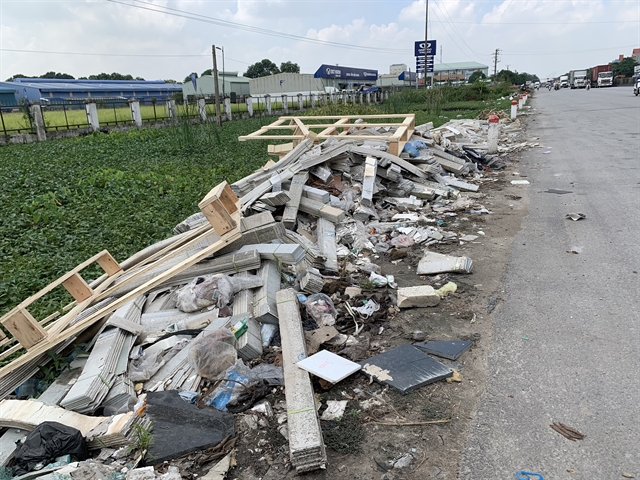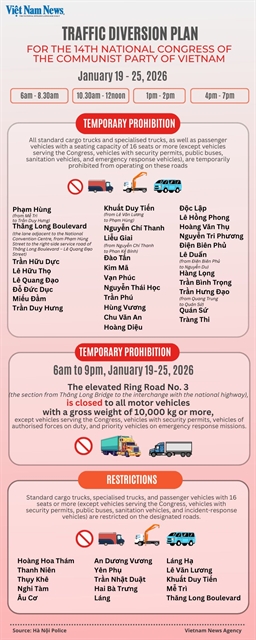 Environment
Environment

As many as 37,000 tonnes of solid waste is generated daily in urban areas, according to the Ministry of Natural Resources and Environment (MONRE).

|
| Construction waste littered along the section of National Road No.5 that runs through Cẩm Giàng District, the northern province of Hải Dương. — VNA/VNS Photo Hiền Anh |
HÀ NỘI — As Việt Nam is undergoing infrastructure development which brings mounting waste, recycling construction waste is necessary because it will not only take advantage of the resource but also protect the environment, experts have said.
As many as 37,000 tonnes of solid waste is generated daily in urban areas, according to the Ministry of Natural Resources and Environment (MONRE).
Of that, construction waste accounts for between 12-15 per cent.
In 2007, the Government issued a resolution on solutions to renovate and rebuild degraded apartments. Therefore, a large amount of construction waste would be discharged in big cities and urban areas in the coming years, said a MONRE representative.
“It will cause great pressure on the environment if the waste issue is not properly handled,” he told Kinh tế và đô thị (Economic and Urban Affairs) newspaper.
There were more than 2,200 apartments built in the 1970s and 1980s in urban areas and most of them are seriously degraded.
According to Ngô Kim Tuấn from Hà Nội Construction University, construction waste consists of soil, sand and gravel (36 per cent), bricks and masonry (31 per cent), concrete (23 per cent), and metal and plastic (10 per cent).
The most common treatment method in Việt Nam is dumping into the environment and burying in landfills.
Between 50-55 per cent of construction waste generated daily in big urban areas is treated in landfills. Materials that can be recycled such as steel, metal, wood and plastic are classified at garbage collection points and sold for recycling.
The remaining waste was dumped illegally into the environment, Tuấn said.
“Dealing with illegal dumping of construction waste is a big challenge for all stakeholders,” he said.
Trần Công Hưng, from the Việt Nam Association for Conservation of Nature and Environment, agreed.
“While the resources for construction are increasingly exploited and at risk of exhaustion, the burial of construction resources is a big waste,” he said.
"The burying of construction waste not only affected the environment and urban area’s beauty but the settlement for illegal dumping of construction waste also required a large amount of money."
Management
The Government have issued many regulations related to the handling of construction waste over the past five years.
The Construction Law on 2014 stipulates that contractors bear responsibility for the management of construction waste.
A National Strategy for Integrated Management of Solid Waste has been introduced by the Government. It is expected that all solid waste will be collected, recycled and completely treated by advanced, environmentally-friendly technologies suitable for each locality by 2050.
The importance of waste recycling has also been emphasised in the amended Law on Environmental Protection.
However, these regulations and strategies on solid waste management have failed to promote sound management of construction waste due to a lack of guiding documents, experts said.
The country also lacked technical standards for using by-products of treated waste, they said.
Research from the World Bank showed that each year Việt Nam loses 5 per cent of GDP, equivalent to US$10 billion, due to environmental pollution.
With the current economic development and urbanisation rate, the volume of waste in urban areas increases by nearly 9 per cent annually and the total amount of waste in the country is estimated at 54 million tonnes by 2030.
If construction waste is managed, utilised and handled properly, it can be recycled and replace natural exploited materials, it said.
Tuấn suggested the main components of construction waste such as soil, bricks and concrete can be recycled through proper treatment and be used for other construction sites.
For example, the land used to produce clay bricks can be used for road foundation materials.
“The use of recycled materials contributes to saving resources and minimising environmental pollution at the same time,” he said. — VNS




